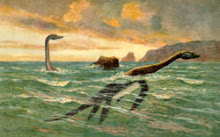Many explanations have been postulated over the years to describe what kind of animal the Loch Ness Monster might be. These fall into three categories: (1) misidentification of known animals; (2) unknown species; (3) paranormal creatures.
Known Animals
It has been suggested that at least some of the sightings might be explained by large pike (Esox lucius) , sturgeon, or dolphins. Land animals dogs, deer, and otters have been seen in the water: even a bird viewed through binoculars could be mistaken for a head and neck.
Elephant
A theory presented by Neil Clark, the curator of paleontology at the Hunterian Museum in Glasgow has suggested that Nessie could merely be a swimming elephant, as there was a travelling circus passing through the area during the heyday of the sightings. Bertram Mills used to take his circus to Inverness, Scotland. When they passed Loch Ness the circus would stop to allow the animals to rest and bathe. When the elephants were allowed to swim in the Loch, "only the trunk and two humps could be seen: the first hump being the top of the head and the second being the back of the animal." When the Loch Ness Monster story broke, Bertram Mills was confident enough that the creature did not exist to offer a £20,000 reward, £1 million in today’s money, to anyone who could catch the monster. No one ever collected on the reward, and Mills gained much publicity.
Unknown Species
Plesiosaur
Plesiosaurs, by Heinrich Harder, 1916.
The most common eyewitness description of Nessie is that of a plesiosaur, a long-necked aquatic reptile that became extinct during the Cretaceous–Tertiary extinction event. Supporters of the plesiosaur theory cite the survival of a fish called the coelacanth, which supposedly went extinct along with the plesiosaur but was rediscovered off the coast of South Africa in 1938.
On the other hand, mainstream science does offer plausible reasons why such an animal could not exist in Loch Ness. Apart from its apparent extinction, the plesiosaur was probably a cold-blooded reptile requiring warm tropical waters, while the average temperature of Loch Ness is only about 5.5°C (42°F). Even if the plesiosaurs were warm-blooded, they would require a food supply beyond that of Loch Ness to maintain the level of activity necessary for warm-blooded animals.
Moreover, there is no substantive evidence in the bone structure of fossilised plesiosaurs that indicate sonar capability (similar to that possessed by dolphins and whales). Such a system would be necessary in the loch, as visibility is limited to less than 15 feet due to a high peat concentration in the loch. Consequently, sunlight does not deeply penetrate the water, limiting the amount of photosynthetic algae, thereby reducing the number of plankton and fish in the food chain. Fossil evidence indicates plesiosaurs were sight hunters; it is unlikely that the loch's peat-stained water would allow such animals to hunt the limited food supply at sufficient levels.
In October 2006, Leslie Noè of the Sedgwick Museum in Cambridge pointed out that, "The osteology of the neck makes it absolutely certain that the plesiosaur could not lift its head up swan-like out of the water", precluding the possibility that Nessie is a plesiosaur.
Long-necked seal
Peter Costello posed the theory that Nessie and other reputed lake monsters were actually an unknown species of long-necked seal. This theory is supported by several sightings of the monster on land, during which the creature supposedly waddled into the loch upon being startled, in the manner of seals. However, all known species of pinnipeds are usually visible on land during daylight hours to sunbathe , something that Nessie was never known to do.
Eel
Some have theorized that "Nessie" may be a giant eel. They believe that an eel might have grossly enlarged in order to eat the bigger fish, or that a larger eel species inhabits the loch. But eels are not known to protrude swanlike from the water as described in some sightings.
Invertebrates
Frank Holiday proposed that Nessie and other lake monsters such as Morag could be explained by a giant invertebrate, and cited the extinct Tullimonstrum as an example of the shape. He says this provides an explanation for land sightings and for the variable back shape, and relates it to the medieval description of dragons as "worms".
Kelpie
According to the Swedish naturalist and author Bengt Sjögren (1980), present day beliefs in lake monsters such as Nessie are associated with the old legends of kelpies. He claims that the accounts of loch monsters have changed over the ages, originally describing a horse appearance, they claimed that the "kelpie" would come out of the lake and turn into a horse. When a tired traveller would get on the back of the kelpie, it would gallop into the loch and devour its prey. This myth successfully kept children away from the loch, as was its purpose. Sjögren concludes that the kelpie legends have developed into more plausible descriptions of lake monsters, reflecting awareness of plesiosaurs. In other words, the kelpie of folklore has been transformed into a more "realistic" and "contemporary" notion of the creature. Believers counter that long-dead witnesses could only compare the creature to that which they were familiar -- and were not familiar with plesiosaurs.
Holiday has also ascribed the difficulty of obtaining good evidence as due to something other than chance: either a psychological reluctance to accept the unwelcome truth (and therefore unconscious failures to operate equipment etc.) or some actual paranormal effect, and possible connection with UFOs.

The rhomboid fin photograph, the "flipper" photograph. The image is known to have been retouched from the original. The Museum of Hoaxes shows the original unenhanced photo.
Pretplati se na:
Objavi komentare (Atom)

Nema komentara:
Objavi komentar